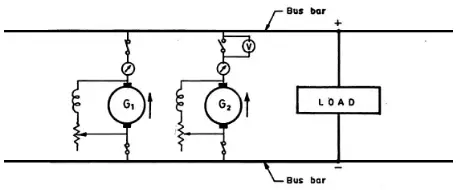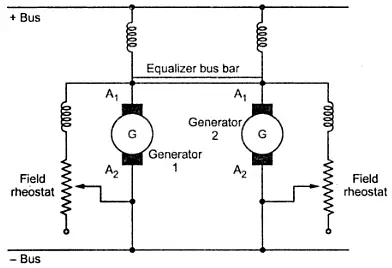For supplying a large DC load, it is desirable to use more than one generator in parallel. This arrangement provides the security that if one generator gives way, the other(s) can feed part load.
Desirable Conditions for DC Generators in Parallel
- Same voltage rating
- Same percentage voltage regulation
- Same percentage speed regulation of the prime mover
As the generator voltage is easily adjustable (in a range), so the above conditions are not a must.
Advantages of Parallel Operation of Generators
- Continuity of service
- Larger efficiency
- More convenient to maintenance and repair
- Additions to plant
- Increased stability
Shunt Generator in Parallel

Shunt generators are best suited for parallel operation due to their drooping characteristics. The generator with more drooping characteristic carries the small load.
It is evident that if shunt generators are to divide the load properly at all points, their characteristics must be similar in form and each must have the same voltage drop from no load to full load.
Series Generators in Parallel
Fig. 2 shows two identical series generators connected in parallel. Suppose E1 and E2 are initially equal, generators supply equal currents and have equal currents and have equal shunt resistances. Suppose, E1 increases slightly so that E1>E2. In that case, I1 becomes greater than I2. Consequently, the field of machine 1 is strengthened thus, increasing E1 further whilst the field of machine 2 is weakened thus, decreasing E2 further. A final stage is reached when machine 1 supplies not only the whole load but also supplies power to machine 2 which starts running as a motor. Obviously, the two machines will form a short-circuited loop and the current will rise indefinitely. This condition can be prevented by using the equalizing bar because of which two similar machines pass approximately equal currents to the load, the slight difference between the two currents being confined to the loop made by the armatures and the equalizer bar.

Compound Generators in Parallel
In Fig. 3, there are shown two compound generators (designated as 1 and 2) running in parallel. Because of the rising characteristics of the usual compounded generators. It is obvious that in the absence of any corrective devices, the parallel operation of such generators is unstable. Let us suppose that to being with each generator is taking its proper share of the load. Now, let us assume that for some reason, generator 1 takes a slightly increased load. In that case, the current passing through its series winding increases which further strengthens its field and so raises its generated emf thus, causing it to take still more load. Since the system load is assumed to be constant, generator 2 will drop some of its load, thereby weakening its series field which will result in its further dropping-off its load. Since this effect is cumulative. Therefore, generator 1 will tend to take the entire load and finally drive generator 2 as a motor. The circuit breaker of at least one of the two generators will open thus, stopping their parallel operation.

For making the parallel operation of over-compound and level-compound generators stable, they are always used with an equalizer bar connected to the armature ends of the series coils of the generators. The equalizer bar is a conductor of low resistance.
For maintaining a proper division of load from no-load to full-load, it is essential that
(a) the regulation of each generator is the same.
(b) the series field resistances are inversely proportional to the generator rating.
